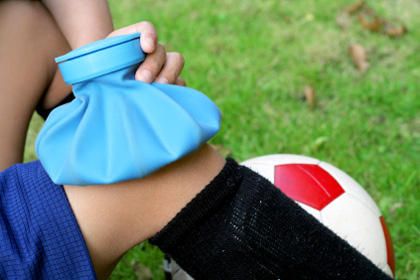 After a tournament soccer game last summer, tween Eric Blair’s foot hurt so much he couldn’t walk back to the car. Mom Michelle Blair rushed him to an urgent care facility near their home in Portland, Ore., where he was diagnosed with Sever’s disease, an inflammation of the heel growth plate.
After a tournament soccer game last summer, tween Eric Blair’s foot hurt so much he couldn’t walk back to the car. Mom Michelle Blair rushed him to an urgent care facility near their home in Portland, Ore., where he was diagnosed with Sever’s disease, an inflammation of the heel growth plate.
“The solution was two weeks of rest, icing and stretches,” says Blair. “Still, the injury persisted, and plantar fasciitis added to Eric’s discomfort.”
After the two weeks, Blair asked a podiatrist if Eric could return to the soccer field. The podiatrist assured her Eric wouldn’t suffer permanent damage to his foot; if he wanted to play through the pain, he could. He kept playing.
Dr. Rosemary Agostini, medical chief of Activity, Sport and Exercise Medicine, a new service at Seattle’s Group Health, often treats teens who play summer sports with foot, ankle and knee injuries.
“Teens are being pushed to do too much activity these days,” says Agostini. “They need to take a season off from sports once in a while — and they should never play or practice more than one sport on the same day.”
Parents need to monitor the intensity, frequency and duration of their teen’s activities, Agostini says. “If kids report pain, they should stop participating in the sport until the pain disappears.”
Sports injuries are common among kids
About 30 million teens and 38 million children younger than age 14 play sports. One out of every 10 of these young athletes gets injured, says Kathryn Wilder, Ph.D., a performance consultant in Doylestown, Penn. Most of these injuries occur as a result of impact experienced during contact sports, like football, or in sports where swift movements are used, such as soccer and basketball.
Among 12- to 17-year-olds, sports-related injuries are the leading cause of emergency room visits, according to the Centers for Disease Control and Prevention. The most common sports injuries among kids in this age group are sprains and broken bones, says Wilder.
Some sports injuries are increasing, both in incidence and severity. Take cheerleading. At one time considered an activity, not a sport, cheerleading has become more competitive, athletic and physically demanding. In one case, reports Agostini, the girls at the bottom of a cheer pyramid dropped the “flyer,” the girl they toss in the air. The fall broke her back.
“If your teen cheers for her school, make sure that the coach is experienced, monitors his athletes, and that mats are being used on the floor,” says Agostini. “Head, neck and back injuries are very serious.”
Watch for eye injuries
Sports accidents are the top cause of eye injuries in children younger than 16, according to the Consumer Product Safety Commission (CPSC).
Derek Cunningham, an Austin, Texas, optometrist, says the most common eye injuries — black eyes and bruising — typically do not threaten sight. But he also sees broken blood vessels in the eyes and — most serious — damage to the eyeball itself.
“When participating in water sports, the water reflects UV light and can burn the cornea if safety eyewear is not worn,” says Cunningham. “This holds true for people who are fishing and waterskiing.”
Organized baseball teams typically require eye protection for young athletes, but that’s not always the case for the base runners and fielders — which is where Cunningham sees more serious injuries. But whether or not your child wears protective eyewear, vision problems require medical attention, he says. “Any trauma to the eye needs to be checked out.”
All safety equipment, such as eyewear, helmets and face guards, should fit correctly. That includes sports shoes and even non-sports shoes, says Agostini. “Kids who play sports shouldn’t wear flip-flops or UGG boots during non-playing time, because their feet need support,” she says.
What else can teens do to help prevent sports injuries? “They should avoid fatigue, stay hydrated and eat small meals often,” Agostini says. They should also snack an hour before a sports activity and, if they play for more than an hour, drink a beverage that contains sodium and potassium.
Parents shouldn’t let kids play or practice when they are ill. “That stress puts them at even more risk for injuries and possible serious medical problems,” says Agostini.
As for Eric Blair? After a season of painful playing, he decided to opt out of competitive soccer. These days, he only plays recreationally. His foot injury doesn’t bother him as much either.
Heather Larson, who lives in Tacoma, frequently writes about parenting and grandparenting for a variety of publications.
Dealing with a serious injury
What to do if your teen’s sports injury prevents him or her from playing:
- Seek a second opinion.
- Locate an expert who can help with the transition.
- Help your child find something else that provides the fulfillment, satisfaction and a sense of belonging that the sport provided.
- Look for another sport that he or she could become passionate about.
- Ask the coach if there’s another role your teen can play so she will still be a part of the “team.”
- Recognize that the change will take time — and be patient.
Source: Kathryn Wilder, Ph.D.











